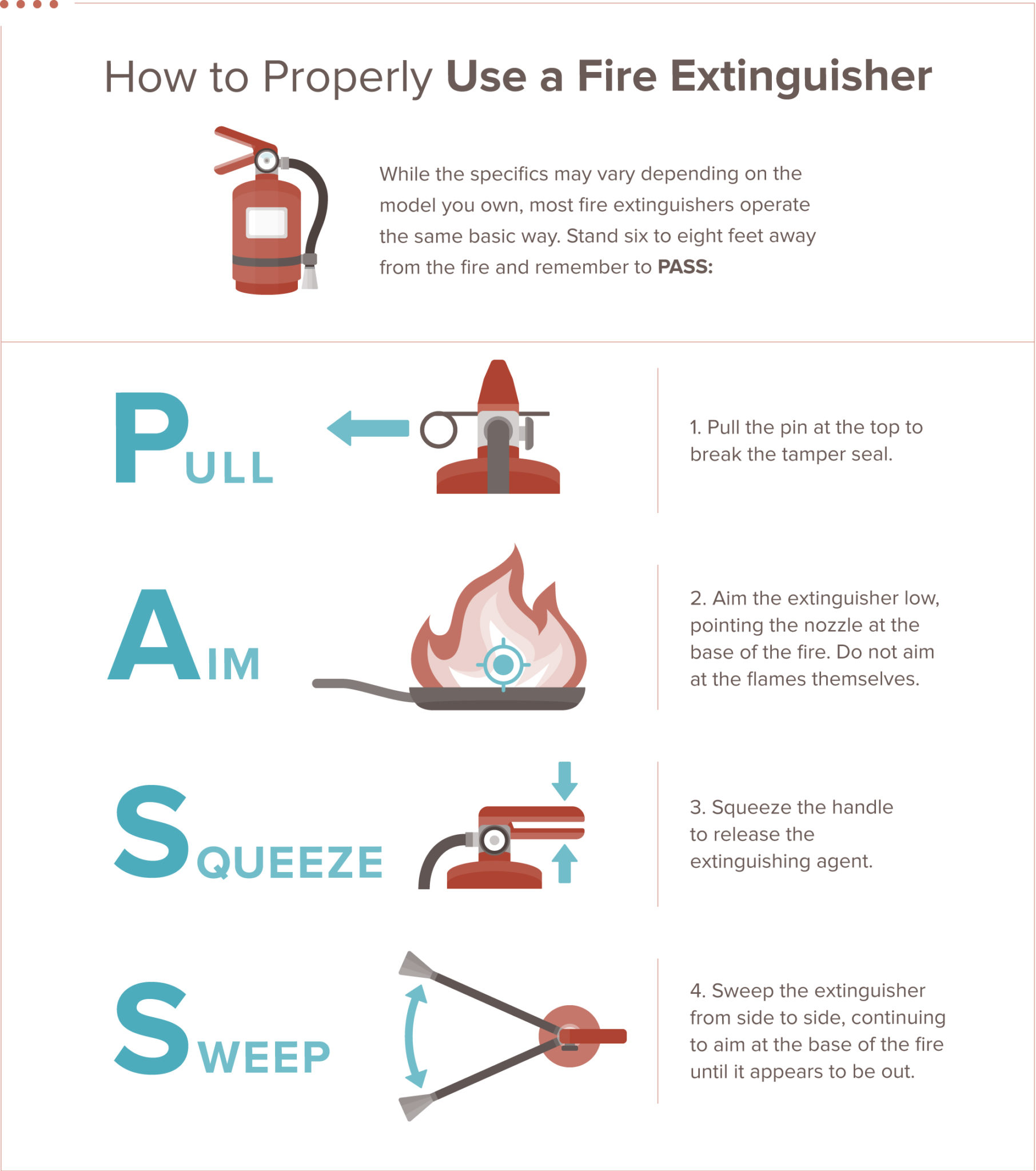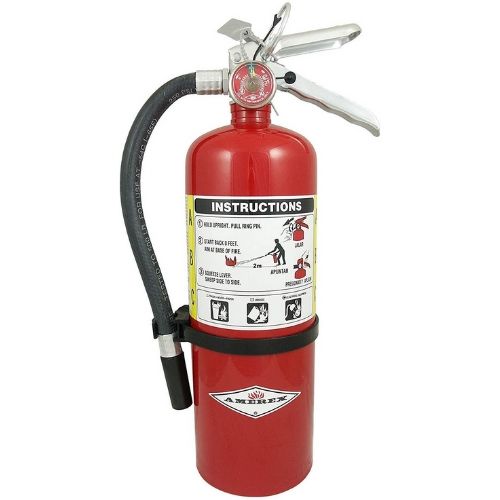We should all have at least one fire extinguisher somewhere in our home, but it’s not enough to simply keep one under the kitchen sink. If there is a fire, your safety—and the safety of your home—depends on knowing how to properly use that fire extinguisher.
In case your fire extinguisher has been sitting around collecting dust, here’s everything you need to know before brushing it off and fighting a fire in your home the right way.
Choose the Right Fire Extinguisher
The first thing you need to know is the different classifications of fires, and the second that not all fire, you need to understand what types of fires you may have to deal with and make sure your extinguisher can get the job done.
Most household fires fall into one of the following categories:
Class A: These fires are fueled by solid combustibles like wood, paper, and cloth.
Class B: These fires are fueled by flammable liquids such as oil, petroleum, and gasoline.
Class C: These fires are started or fueled by faulty wiring, fuse boxes, and appliances.
Class K: These fires are started or fueled by cooking oils and greases, animal fats, and vegetable fats.
All fire extinguishers are labeled to indicate which classes of fire they are designed to combat. Most household fire extinguishers are considered multipurpose and labeled for use in A, B, and C classes. Fire extinguishers safe for Class K fires are heavier duty and will need to be bought separately. We suggest this 6-liter extinguisher, as it best fits the Fire Department Connection’s recommendation.
Fire extinguisher labels also include symbols to indicate which types of fires the extinguisher is designed to fight. If there is a circle and a red slash through any of the symbols, that indicates that the extinguisher cannot be used to fight that type of fire.
Household fire extinguishers are also rated for the size of fire that they can safely handle. The higher the rating, the larger the fire the extinguisher can put out. Class A fires are rated 1 to 40, and Class B fires are rated from 1 to 640. There is no size rating for Class C fires. Note that higher-rated extinguishers are often heavier, so be sure that you can comfortably handle the size of the fire extinguisher you keep at home.
Steps for Proper Fire Extinguisher Use
Once you understand the different types of fire extinguishers and their uses, you need to be able to properly operate one.
The best way to be ready for a fire emergency in your home is to study the steps below and review them regularly so you can protect your home and family.
1. Identify a Clear Exit/Escape Route
Before operating the fire extinguisher, make sure you have a clear evacuation route. If you cannot put out the fire, you’ll need to make a safe exit. Consider this when determining where to store your fire extinguisher, and make sure you’ll have multiple exit options nearby after you retrieve it.
2. Stand Back
Face the fire and keep your back to the clear exit you earlier identified. You should stay between six and eight feet away from the flames as you prepare to operate the fire extinguisher.
3. Discharge Extinguisher
It can be difficult to think clearly during an emergency, so fire safety has a long-standing acronym to help you recall the steps involved in operating your fire extinguisher. Just remember PASS:
P: Pull the pin on the fire extinguisher.
A: Aim the nozzle on the hose low, toward the base of the fire.
S: Squeeze the handle or lever to discharge the extinguisher.
S: Sweep the nozzle back and forth. Keep the fire extinguisher aimed at the base of the fire and move it from side to side until the flames are extinguished.

4. Keep an Eye on Things
After the flames appear to be out, continue to watch the fire area to make sure it doesn’t reignite. If the fire does start up again, repeat the PASS process.
5. Call the Fire Department
If you didn’t have the chance to call the fire department before discharging the fire extinguisher, do so now. They will be able to inspect the site of the fire and make sure that it is completely extinguished.
6. Get to a Safe Place
Once the fire is out, or if you are unable to extinguish the fire, leave the scene and find a place out of reach of the fire.
Common Fire Extinguisher Mistakes
Because we don’t have regular opportunities to practice fighting fires, it’s easy to make simple mistakes when the time comes. Know where most people go wrong so you can avoid making a mistake while under pressure.
-
-
- Don’t Ignore the Instructions: Thoroughly read the operating instructions that came with your fire extinguisher. Make sure all able members of your home read and understand the instructions. Review them regularly when you conduct fire drills and go over your evacuation plan.
- Don’t Use the Wrong Type of Fire Extinguisher: Never use a fire extinguisher for a class of fire that is not indicated on the label. Most importantly, extinguishers that are labeled for Class A fires only cannot be used on electrical or grease fires. However, it is safe to use an extinguisher labeled for Class B and C fires on a Class A fire. While Class K fires are technically a subset of Class B fires, other contents in Class B extinguishers can make Class K fires worse, so it’s best to get a separate extinguisher for cooking fires.
- Don’t Let Your Extinguisher Go Bad: Fire extinguishers come with an expiration date, after which the extinguishing agent is no longer effective. Know the dates on your fire extinguishers and replace them as needed.
- Don’t Forget about Exits: When you decide where to keep your fire extinguisher, make sure it is in an easily accessible location near exterior doors. Also, consider the most common places where fires occur in a home and place your extinguishers accordingly.
- Don’t Keep It a Secret: Make sure that everyone in your home knows where the fire extinguishers are kept. Share the location, along with your entire fire escape plan, with babysitters, house sitters, and any long-term visitors.
-
Next Steps
The best way to keep your home and family safe in the event of a fire is to be prepared. Get to know your fire extinguishers and regularly review how to properly use them. A little advance practice can make all the difference when you’re faced with the stress of an actual fire in your home.
Need a fire extinguisher? Check out our buyer’s guide: Best Fire Extinguishers
The post Be Prepared: How to Properly Use a Fire Extinguisher appeared first on SafeWise.
Aricle source here: Be Prepared: How to Properly Use a Fire Extinguisher

No comments:
Post a Comment